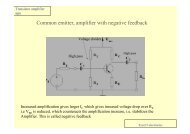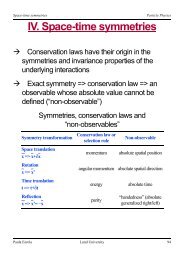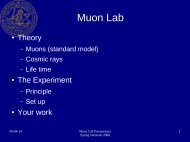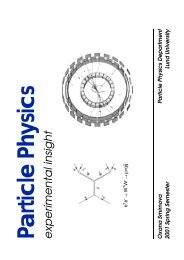8. QCD
8. QCD
8. QCD
You also want an ePaper? Increase the reach of your titles
YUMPU automatically turns print PDFs into web optimized ePapers that Google loves.
Quantum ChromodynamicsThe theory of strong interactionsVincent HedbergV. Hedberg Quantum Chromodynamics 1
Quantum ChromodynamicsInteractions by massless spin-1 particles: Gauge bosonsQuantum electrodynamics (QED): PhotonsQuantum chromodynamics (<strong>QCD</strong>): GluonsQED: Photons couple to electric charges (Q)<strong>QCD</strong>: Gluons couple to colour charges (Y c and I c ).3Y c : colour hypercharge.I c : colour isospin charge.3The strong interaction is flavour-independent:It acts the same on u,d,s,c,b and tV. Hedberg Quantum Chromodynamics 2
Quantum ChromodynamicsThe colour hypercharge (Y c ) + the colour isospin charge (I c )three colour and three anti-colour quark states3<strong>QCD</strong>Y c Ic3r 1/3 1/2g 1/3 -1/2b -2/3 0Y c Ic3r -1/3 -1/2g -1/3 1/2b 2/3 0Colour confinement:Mesons and baryons total colour charge = 0.Colour wave-functions:<strong>QCD</strong>11qq = (rr+gg+bb)3q 1 q 2 q 3 = (r 1 g 2 b 3 -g 1 r 2 b 3 +b 1 r 2 g 3 -b 1 g 2 r 3 +g 1 b 2 r 3 -r 1 b 2 g 3 )6V. Hedberg Quantum Chromodynamics 3
Quantum Chromodynamics<strong>QCD</strong>: Colour hypercharge (Y c ) and colour isospin charge (I c )3Quark model: Flavour hypercharge (Y) and flavour isospin (I 3 )Quark ModelQ Y I 3 Q Y I 3d -1/3 1/3 -1/2u 2/3 1/3 1/2s -1/3 -2/3 0d 1/3 -1/3 1/2u -2/3 -1/3 -1/2s 1/3 2/3 0c 2/3 4/3 0 c -2/3 -4/3 0b -1/3 -2/3 0 b 1/3 2/3 0t 2/3 4/3 0 t -2/3 -4/3 0The total wavefunction of hadrons:ψ total = ψ space x ψ spin x ψ flavour x ψ colourV. Hedberg Quantum Chromodynamics 4
Quantum ChromodynamicsPhotons electric charge = 0 !Gluons have colour charge !Gluons exist in 8 different colour states:χ C = r g g1 IC = 1 CY = 03<strong>QCD</strong>χ C = r g g2 IC = C1 Y = 03χ C = r b g3 IC = 1/2 CY = 13χ C = r b g4 IC = C1/2 Y = 13χCg5= g b I C = C1/2 Y = 13χ C = g b g6 IC =1/2 CY = 13χ C = 1/ 2 ( g g - r r ) I C = 0 CY = 0g7 3χ C = 1/ 6 ( g g - r r - 2 b b )g8I C = 0 CY = 03Color confinement Gluons do not exist a free particles.V. Hedberg Quantum Chromodynamics 5
Quantum ChromodynamicsColour hypercharge + colour isospin charge are additivequantum numbers (like the electric charge).Example:I C 3 = 1/2 CY = 1/3uuI C 3 = 0 C _Y = 2/3gluonI C 3 = 0 C _Y = 2/3ssI C 3 = 1/2 CY = 1/3Gluon:I 3CY CIC 3 ( r)I3 C 1= – ( b)= --2= Y C ( r) – Y C ( b)= 1χcg3 = r bV. Hedberg Quantum Chromodynamics 6
Quantum ChromodynamicsGluons can couple to other gluons(since they carry colour charge).<strong>QCD</strong>: Gluons can form colourless states.GlueballsExperiments: Difficult to prove existance of glueballs.Leptons have no colour charge.They do not interact strongly.V. Hedberg Quantum Chromodynamics 7
Quantum ChromodynamicsThe strong coupling constantQED: The electromagnetic coupling contant:α em<strong>QCD</strong>: The strong couplings constant: α sα s : “running constant” Decreases with increasing Q 2What is Q 2 ?The 4-vectors of the interacting quarks:P= (E,p) = (E,p x ,p y ,p z )uuThe 4-vectors of the quarks 4-vector of gluong*qq = (E q ,q) = P 1 P 2 = (E 1 - E 2, P 1 P 2 )P 1 P 2P 4P 3ssThe squared 4-vector energy-momentum tranfer:Q 2 = q . q (i.e. Q = the “mass” of the gluon)V. Hedberg Quantum Chromodynamics 8
α s=Quantum Chromodynamics<strong>QCD</strong> prediction:-------------------------------------------------------12π( 33 – 2N f) ln( Q 2 ⁄ Λ 2 )N f : Number of allowed quarkflavoursThe strong coupling constant0.5α s (Q)0.40.30.2DataTheoryDeep Inelastic Scatteringe + e - AnnihilationHadron CollisionsHeavy QuarkoniaΛ(5)MSNLONNLOLatticeα s(Μ Z){275 MeV 0.123<strong>QCD</strong>O(α 4 220 MeV 0.119s)175 MeV 0.115Λ: <strong>QCD</strong> scale parameterDetermined experimentally(Λ≈0.2 GeV)0.11 10 100Q [GeV]V. Hedberg Quantum Chromodynamics 9
Quantum ChromodynamicsThe quark-antiquark potential (mesons)V(r)Breaking of the stringqrqSpring-likeVr ( ) = λr (r ≥ 1fm)rThe strong couplings constantrCoulomb-likeVr ( )=4-- α s– ----- (r < 0,1 fm)3 rV. Hedberg Quantum Chromodynamics 10r
Quantum ChromodynamicsThe principle of asymptotic freedom.<strong>QCD</strong> - Short distances - interaction is weaker<strong>QCD</strong> - Long distances - interaction is strongerSmall distance Coulomb-like potential quarks and gluonsSmall distance large Q 2 small α sfree particlesSmall distancesLarge distancesfirst order diagrams.higher order diagrams.Higher-order diagramsConfinement cannot be calculated analyticallyV. Hedberg Quantum Chromodynamics 11
Electron-positron collisions+ -eeV. Hedberg Quantum Chromodynamics 12
Electron-positron annihilationThe R-value from e + e - experimentsMeasurement:R σ ( e+ e - → hadrons)≡ -----------------------------------------------σ( e + e - → μ + μ - )rate of collisions that give hadronsrate of collisions that give muonsPrediction from theory:R = N c Σe2qN c is the number of colours (=3)e q the charge ofthe quarks.V. Hedberg Quantum Chromodynamics 13
Electron-positron annihilation2 2 22 2 2R =N c ( e u +e d +e s ) = 3 ((-1/3)+(-1/3)+(2/3)) = 22 2 2 2R =N c ( e u +e d +e s +e c )=10/32 2 2 2 2R =N c ( e u +e d +e s +e c +e b )=11/3ifififs
Electron-positron annihilationJets of particlese + e - annihilation process:A photon or a Z 0 is producedquark-antiquark pair.The quark and the antiquark fragment into observable hadrons.PETRA(DESY)hadronsLEP(CERN)hadronse - e +7-22 GeVqγ *Length: 2.3 kmExperiments: Tasso, Jade, Pluto, Mark J, Celloq-hadrons7-22 GeVe - e +45-104 GeVqZ 0hadrons45-104 GeVLength: 27 kmExperiments: DELPHI, OPAL, ALEPH, L3q-V. Hedberg Quantum Chromodynamics 15
Electron-positron annihilationTwo jets of particlesThe direction of the jet The direction of the quarkTwo-jet events in the Jade experimentTwo-jet events in theory:e +e - γ ∗ qqjets of hadronse + + e - → γ ∗ → hadronsEnergy and momentum conservationThe quark and anti-quark have equal energy and opposite directionJets have the same energy and opposite directionV. Hedberg Quantum Chromodynamics 16
Electron-positron annihilationThe angular distribution of 2 jetsand the spin of the quarks.e + + e - → γ ∗ → μ + + μ -dσd-------------- (cosθe + e- → μ + μ-)=---------πα 22Q 2 ( 1 + cos2 θ)eμθμee + + e - → γ ∗ → q + qdσd(cosθ→ qq ) = N ce2πα 2q --------- ( 1 + cos2 θ)2Q 2quark spin = 1/2dσd(cosθ→ qq ) = N ce2πα 2q --------- ( 1–cos2 θ)2Q 2quark spin = 0N c is the numbere q is the quark chargeof colours (=3)V. Hedberg Quantum Chromodynamics 17
Electron-positron annihilation1+cos 2 θ(spin 1/2)The experimental data1-cos 2 θ(spin 0)Conclusion: Quarks have spin = 1/2 !V. Hedberg Quantum Chromodynamics 18
The discovery of the gluonThe accelerator: PETRA at the German laboratory DESY.V. Hedberg Quantum Chromodynamics 19
The discovery of the gluonThe experiment: TASSOMuon detectorDriftchamberMagnet coilCherenkov detectorLiquid Argon CalorimeterV. Hedberg Quantum Chromodynamics 20
The discovery of the gluonJadeTassoThree-jet events in theory:e +e - γ ∗ qqgjets ofhadronsThree-jet events The third jet from a gluon !V. Hedberg Quantum Chromodynamics 21
The discovery of the gluonThe probability for gluon emission is proportional to α s .α s=Number of three-jet eventsNumber of two-jet events0.5α s (Q)0.4DataTheoryDeep Inelastic Scatteringe + e - AnnihilationHadron CollisionsHeavy QuarkoniaNLONNLOLatticePETRA:α s =0.15 ± 0.03fors = 30-40 GeV0.30.2Λ(5)MSα s(Μ Z){275 MeV 0.123<strong>QCD</strong>O(α 4 220 MeV 0.119s)175 MeV 0.1150.11 10 100Q [GeV]V. Hedberg Quantum Chromodynamics 22
Electron-positron annihilationAngular distribution of 3 jets and the spin of the gluon.E maxJet 1θ 3θ 2θ 1Jet 3Jet 2E mingluon spin = 0gluon spin = 1cosφ=-sinθ 2sinθ 3sinθ 1Angular distribution Gluons have spin = 1V. Hedberg Quantum Chromodynamics 23
Electron-positron annihilationHadronization<strong>QCD</strong>freeparticlesElectro weakV. Hedberg Quantum Chromodynamics 24
Electron-proton collisionseprotoneprotonV. Hedberg Quantum Chromodynamics 25
Electron-proton scatteringλ >> r p Very low electron energiesScattering from a “point-like” spin-less object.e -γ*Q 2lowλ = r p Low electron energiese -Scattering from an extended charged object.γ*λ < r pHigh electron energiesInteractions with the valence quarks in the proton.e -γ*λ
Electron-proton scatteringElastic scatteringElastic scattering: The same type of particles before and after.lepton = e or μP 1 P 2gauge boson = γ*q = P 1 P 2= ( ν, q)P 3hadron = pP 4 = P 3 + qElastic electron-proton scattering Size of the protonV. Hedberg Quantum Chromodynamics 27
Electron-proton scatteringDifferential cross sectionThe differential cross sectiondσ( θϕ , )---------------------dΩgives the angular distribution.sinθdθdϕdΩ=dA------L 2The total cross section by integration:σdσ---------------------( θϕ , )= dΩ =dΩπ 2πdσ---------------------( θϕ , )sinθdθdϕdΩ0 0V. Hedberg Quantum Chromodynamics 28
Electron-proton scatteringElastic scattering on a static point-like charge.electronPmelectrone θPoint-like chargeM>>mThe Rutherford scattering formulaNon-relativistic electronPoint-like electric charge e.-------dσdΩRm 2 α= --------------------------2 α4p 4 4 θsin --2=e 2-----4πThe Mott scattering formulaRelativistic electronPoint-like electric charge e.dσ------- dΩM=α 2-------------------------- m 2 p 2 2 θ+ cos --4p 4 4 θ 2sin (--)2V. Hedberg Quantum Chromodynamics 29
Electron-proton scatteringElastic scattering on an extended charged object.P 2eρ( r)electronP θ1relectronStatic sphericalcharge distributionMomentum transferq = P 1 P 2q 2 = q . qρ(r): a spherically symmetric density function withρ(r): describes how the charge e is spread out.3rdx = 1Not point-like interactionRutherford formula modified by electric form factor G E (q 2 )dσ-------dΩ=dσ-------dΩR G E 2 ( q 2 )q = P 1 P 2dσ-------dΩR--------------------------m 2 α 24p 4 4 θsin --V. Hedberg Quantum Chromodynamics 30=2
Electron-proton scatteringThe electric form factor is the Fourier transform of the chargedistribution with respect to the momentum transfer q:G Eq 2 = re iqxd3 xThe electric form factor has values between 0 and 1:Low momentum transfer:High momentum transfer:G E( 0) 1= forq = 0G E( q 2 ) → 0 for q 2 → ∞Measurements of the cross-section The form factorThe charge distribution.The mean quadratic charge radiusV. Hedberg Quantum Chromodynamics 31r E23= r 2 rdx =6 dG Eq2 – --------------------dq 2q 2 = 0
Electron-proton scattering-------dσdΩ=G 1Q 2 ( )P 3Pelectron2θP 1 q = P 1 P 2MQ 2 = q . qThe proton mass:Elastic electron-proton scattering-------dσdΩxMelectronprotonP 4Protons have charge + magnetic momentelectric formfactor (G E ) + magnetic formfactor (G M )G 1 Q 2 ( )Q 2cos2 Q 22θ-- +2----------G2M 2 2 ( Q 2 )θsin -- 2G 2 2+ ----------GE 4M 2 M= -------------------------------------Q12G 2 ( Q 2 2) = G M+ ----------4M 24-momentum transferV. Hedberg Quantum Chromodynamics 32
Electron-proton scatteringMeasurement of the formfactors:i) low Q 2 (Q
Electron-proton scatteringIf protons are point-particlesMeasurementsof G E and G Mof the protonG EPoint particleG MG E (Q 2 ) = 1G M (Q 2 ) = 2.79Point particleElectric chargeof a protonMagnetic momentof a protonConclusion:The protonhas anextendedchargedistribution !V. Hedberg Quantum Chromodynamics 34
Electron-proton scatteringInelastic electron-proton scatteringInelastic electron-proton scattering The proton is broken upP 1 P 2q = P 1 P 2P 3Mγ* = ( ν, q)P 4 = P 3 + qQ 2 =q . qelectron4-momentum transferBjorken scaling variablex =Q 22Mν0 < x < 1M is the mass of the proton.V. Hedberg Quantum Chromodynamics 35
Electron-proton scatteringThe differential cross section for inelastic ep scattering:----------------dσdE 2 dΩ--------------------------α 2.=2 θ4E -- 1 sin 4 21--Fν 2 xQ ,2θ( ) cos2 -- + ---- F2M 1( x,Q 2 ) 2θsin 2 --2Dimensionless structure functionsF 1,2 (x,Q 2 ) parameterize the photon-proton interaction in thesame way a G 1 (Q 2 ) and G 2 (Q 2 ) do it in elastic scattering.Bjorken scaling or scale invariance:F 1, 2( x,Q 2 ) = F 1, 2( x)when Q 2 → ∞ and x is fixed and finite.i.e. the structure functions are independent on Q 2 for Q>>M .Scaling: F 1,2 (x,Q 2 ) do not change if masses, energies andmomenta are multiplied by a scale factor.V. Hedberg Quantum Chromodynamics 36
Electron-proton scatteringThe discovery of quarks at the SLAC 2 mile LINAC2 mile linacEnd station AV. Hedberg Quantum Chromodynamics 37
Electron-proton scatteringThe discovery of quarksThe MIT-SLAC experimentThe 20 GeV spectrometerThe 8 GeV spectrometerMagnetsCerenkov detectorsScintillatorsDetectors for e/π separation8 GeV electrons hits a hydrogen targeteprotonV. Hedberg Quantum Chromodynamics 38
Electron-proton scatteringThe discovery of quarksCalculate x and Q 2 from the energy and angle of the electron.e - E 2 Q 2 θ= 4 ⋅ E 1⋅ E 2sin 2 --2e -HadronsθQ 2E γx = -----------------------------------------1 2 ⋅ M ⋅ ( E 1– E 2)Cross section measurement F 2F 2 does not depend on Q 2Protons have a sub-structure(partons)V. Hedberg Quantum Chromodynamics 39
Electron-proton scatteringDeep inelastic electron-proton scatteringThe parton model: Scale invarianceScattering on point-like constituents (partons) in the proton.The quark model: Partons = QuarksP 1 electron P 2γ/Z 0q = P 1 P 2P 3 uproton d uP 3(1-x)P 3Q 2 =x =q . qQ 22Mν==θ4 ⋅ E 1⋅ E -- 2sin 2 2Q 2-----------------------------------------2 ⋅ M ⋅ ( E 1– E 2)xParton/quark model Fraction of the proton momentum carriedby the struck quark is given by Bjorken x.V. Hedberg Quantum Chromodynamics 40
Electron-proton scatteringDeep inelastic electron-proton scatteringParton model F 1 depends on the spin of the partons (quarks)Prediction:The Callan-Gross relation:F 1 ( xQ , 2 ) = 0 quark spin =02xF 1 ( xQ ,2 ) = F 2 ( xQ ,2 ) quark spin=1/2Measurement:2xF 1F 2MeasurementTheory prediction:Spin = 1/2Spin = 0Bjorken xV. Hedberg Quantum Chromodynamics 41
Electron-proton scatteringPETRA(DESY)hadronsLEP(CERN)hadronse - e +7-22 GeVqγ *hadrons7-22 GeVLength: 2.3 kmExperiments: Tasso, Jade, Pluto, Mark J, Celloq-e - e +45-104 GeVqZ 0hadrons45-104 GeVLength: 27 km (4184 magnets)Experiments: DELPHI, OPAL, ALEPH, L3q-LINAC(SLAC)e -1.6, 8, 20 GeVhadronsγe -Length: 3 kmExperiments: SLAC-MITe0 GeVqgqgqgpHERA(DESY)Length: 6 km (1650 magnets)Experiments: H1, ZEUSV. Hedberg Quantum Chromodynamics 42e +27.6 GeVhadronsγe +e820-920 GeVqgqgqgp
Electron-proton scatteringThe HERA accelerator at DESYHERA accelerator: only large electron-proton collider ever built.Petra was pre-accelerator.6 km longH1V. Hedberg Quantum Chromodynamics 43
HERAElectron-proton scatteringProton accelerator: Super conducting magnets. Energy = 920 GeVElectron accelerator: Normal warm magnets. Energy = 28 GeVCollision energy = 320 GeV (54000 GeV fixed target)Proton acceleratorElectronacceleratorCavitiesfor the electronsV. Hedberg Quantum Chromodynamics 44
Electron-proton scatteringThe H1 ExperimentEvents at HERA were boosted in the proton directiondue to the large difference in electron and proton beam energies.Tracker:Drift- andProportionalchambersMuon detectorsSolenoidmagnetCalorimeter:Liquid argon/lead - emLiquid argon/steel - hadV. Hedberg Quantum Chromodynamics 45
Electron-proton scatteringMeasurement of structure functionsepF 2⋅ 2 i10 510 4x = 0.000050, i = 21x = 0.000080, i = 20x = 0.00013, i = 19x = 0.00020, i = 18x = 0.00032, i = 17x = 0.00050, i = 16x = 0.00080, i = 15x = 0.0013, i = 14x = 0.0020, i = 13x = 0.0032, i = 12H1 e + p high Q 294-00H1 e + p low Q 296-97BCDMSNMCx = 0.0050, i = 1110 3x = 0.0080, i = 10x = 0.013, i = 910 2x = 0.050, i = 610110 -110 6 1 10 10 2 10 3 10 4 10 5x = 0.020, i = 8x = 0.032, i = 7The cross section + the energy andscattering angle of the electronF 2x = 0.080, i = 5x = 0.13, i = 4x = 0.18, i = 3x = 0.25, i = 2x = 0.40, i = 1No quark sub-structure was observeddown to 10 -18 m (1/1000th of a proton)V. Hedberg Quantum Chromodynamics 4610 -210 -3H1 PDF 2000extrapolationx = 0.65, i = 0Q 2 / GeV 2H1 Collaboration
Summary ofscatteringformulasV. Hedberg Quantum Chromodynamics 47
SUMMARY: Electron-Positron interactionse +e - γ ∗ +ll -dσd-------------- cosθe + e- → l + l- πα= --------- 2 2Q 2 ( 1 + cos2 θ)e +e - γ ∗ qqjetsdσd-------------- (cosθe + e- → qq ) = N ce2πα 2q --------- ( 1 + cos2 θ)2Q 2V. Hedberg Quantum Chromodynamics 48
SUMMARY: Elastic electron-proton scatteringPmelectroneelectronθPoint-like chargeM>>m-------dσdΩM=α 2-------------------------- m 2 p 2 2 θ+ cos --4p 4 4 θ 2sin (--)2Static sphericalcharge distribution electron dσelectronPeρ( r)P1 θ 2r-------dΩdσ= -------dΩR G E 2 ( q 2 )Pelectron 2P 3electron θP 1MprotonP 4-------dσdΩ=G 1Q 2 ( )-------dσdΩV. Hedberg Quantum Chromodynamics 49xMG 1 Q 2 ( )Q 2cosθ-- ----------G2 2M 2 2 ( Q 2 )θ+sin -- 22 Q 22G 2 2+ ----------GE 4M 2 M= -------------------------------------Q12 G 2 ( Q 2 2) = G M+ ----------4M 2
SUMMARY: Inelastic electron-proton scatteringE 2ee -θE 1 γHadronsP 1 electron P 2γ/Z 0q = P 1 P 2P 3 uproton d uP 3(1-x)P 3xQ 2 =q . qx =Q 22MνBjorken - xdσ----------------dE 2 dΩ--------------------------α 2 1= .--.ν2 θ4E 1 sin 4 --2F 2 ( xQ ,2 )cos2θ-- Q 22+ ---------xM 2F 1( xQ ,2 )θsin 2 --2V. Hedberg Quantum Chromodynamics 50












